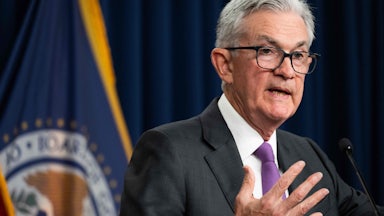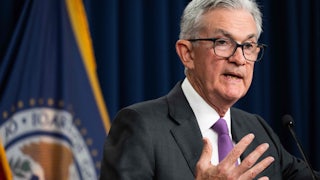If the United States economy is an old Chuck Jones Warner Brothers cartoon—and who’s to say it isn’t?—then Federal Reserve Chairman Jerome Powell is Wile E. Coyote. Wile E. Coyote is always trying and failing to vanquish Roadrunner, who in this allegory stands for economic growth. Wile E. Coyote uses every instrument of destruction he can think of to kill Roadrunner. None of them work. Instead, these assaults make Roadrunner stronger and faster. Wile E. Coyote’s instruments of destruction are mail-ordered from the ACME Corporation. Here, ACME is an allegorized FOMC—that is, the Federal Reserve’s Open Market Committee—and ACME’s anvils, hand grenades, exploding tennis balls, etc., are FOMC’s interest rate hikes.
For nine months, Powell and his FOMC have kept interest rates high, yet the economy continues to grow at a brisk pace. How can it be that Wile E. Coyote’s depredations make Roadrunner stronger and faster? That riddle is addressed in a contrarian new economic theory that, according to Bloomberg’s Ye Xie, “borders on heresy.” According to this theory, higher interest rates do not dampen economic growth, as they’re supposed to, but rather accelerate it. If you want Roadrunner to die, this theory says, stop trying to kill him.
Powell isn’t trying to kill the economy, but he is trying to cool it down in order to contain inflation. Inflation stopped being a serious problem a year ago, but this month it ticked up a mildly worrisome 3.5 percent. “The recent data have clearly not given us greater confidence,” Powell said this week, “and instead indicate that it’s likely to take longer than expected to achieve that confidence.” Translation: There will be no rate cuts any time soon.
Powell wasn’t talking just about inflation. Public opinion to the contrary, the economy is performing extremely well under President Joe Biden. Gross domestic product is up 3.4 percent, corporate profits are up 4 percent, and unemployment remains quite low at 3.8 percent. In March, 303,000 new jobs were created, which was well above expectations. To quote Roadrunner: Mmeemeep!
The idea that interest rate hikes boost economic growth rather than slow it derives from modern monetary theory, or MMT, of which, for complicated reasons I won’t get into here, I am wary. So that’s one strike against it. Another strike is that the concept is quite brilliant. Brilliant ideas tend to be wrong. (See Daniel Farber’s authoritative 1986 law review article, “The Case Against Brilliance,” later adapted into a New Republic article. Before you ask, yes: Farber addressed in both essays the difficulty that his own argument might be brilliant.)
On the other hand, brilliant ideas do occasionally turn out to be right, and we can’t rule out that possibility. The MMT guru Stephanie Kelton, professor of economics at Stony Brook University and author of The Deficit Myth, made the case for rate hikes greasing the economy (and increasing inflation rather than reducing it) in a January post for her Substack newsletter, The Lens.
Kelton’s main argument was that interest hikes “force the Treasury to pay out hundreds of billions of dollars in additional interest,” showering wealthy T-bill investors with cash. Ordinarily, the rich are likelier to bank windfalls than spend them. That’s why tax cuts for the rich, for example, are a lousy way to stimulate the economy during a downturn. But it’s different when interest rates are high, because “tighter credit impedes investment.” Might as well buy that yacht instead! Also, because the economy is beset by monopolization, a lot of businesses “with pricing power” will pass higher borrowing costs on to the consumer, “just like they would if they faced rising wages, shipping, materials, or other costs.” All this is very inflationary.
In the Bloomberg piece, Xie explains that in years past, when higher interest rates goosed spending by bondholders, this effect wasn’t “nearly enough to match the drop in demand from those who stop borrowing money.” Why would it be different this time? Because government debt has gotten so gigantic ($35 trillion) that bondholders rake in $50 billion more than they did a decade ago.
Who else benefits from high interest? “Homeowners holding cheap legacy mortgages,” write Robert Armstrong and Ethan Wu in The Financial Times. A locked-in low mortgage rate makes you less willing to sell your house because you’d have to take out a more expensive loan to buy a new house. The collective result is a drop in supply and an increase in housing costs, already elevated by higher interest rates. If you own a house that you bought before rates went up, send Jerome Powell a thank-you note.
But FT’s Armstrong and Wu don’t actually believe lowering interest rates would cool the economy. Partly, they say, that’s because there’s a long-standing supply shortage in housing. Lower interest rates would increase housing supply, yes, but that wouldn’t lower demand because demand is just too high. Housing prices would continue to rise.
There are other reasons, too, to question the theory that higher interest rates stimulate economic growth, not least that when the Fed started raising interest rates two years ago economic growth did in fact slow, and inflation did indeed come down, even as the Biden administration was moving to stimulate the economy with the infrastructure bill and the CHIPS Act. Today the economy, yes, is booming, but job and wage growth are slowing.
Something to fear is that slowing job and wage growth may not slow the overall economy like they used to. Remember Thomas Piketty’s equation that r > g, where r is capital accumulation and g is economic growth? If the Fed really is inadvertently stimulating rather than slowing the economy by maintaining high interest rates, then we may have to conclude that r and g amount to the same thing—that capital accumulation has so completely swamped labor income in driving the economy that labor income might as well not exist. If you don’t own any capital, or you don’t own a house, that’s hard cheese for you.
Maybe this is why so many Americans have a difficult time believing the economy is firing on all cylinders. If you live on your salary and not your investments, it remains true that—even if the new thinking on interest rates is correct—lower interest rates would serve to make your life easier. Since that describes most Americans, don’t stop hoping Wile E. Coyote will quit chasing Roadrunner and interest rates will come down.










